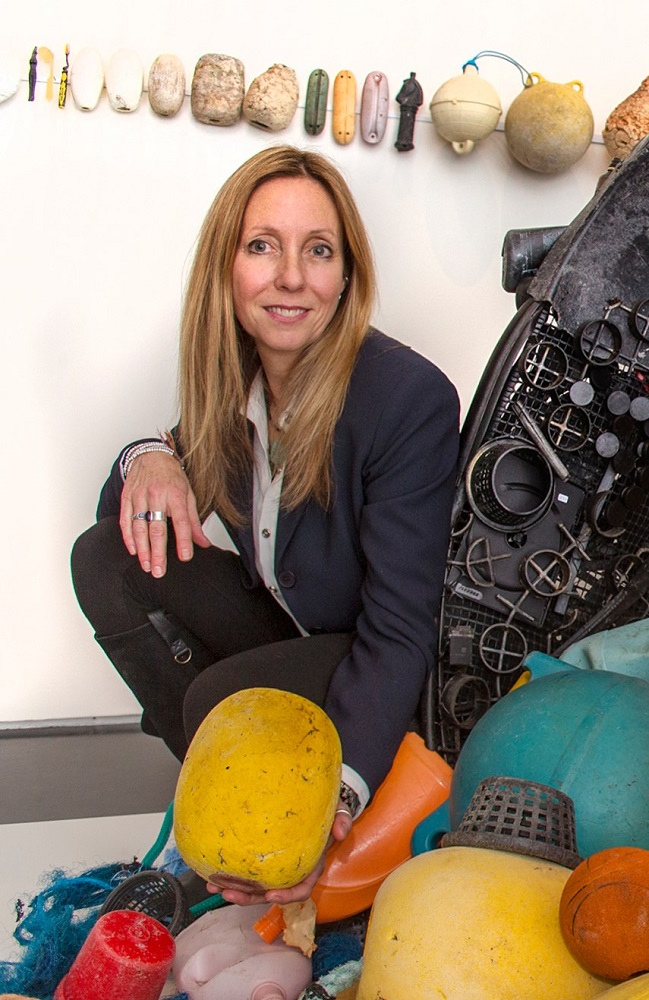Pam Longobardi’s artwork is framed within a conversation about globalism and conservation, and involves painting, photography, and installation. In 2006, she founded the Drifters Project, an international collaborative artistic research project focusing on ocean plastic pollution. She was lead artist on the 2013 GYRE expedition, an art-science research project along Alaska’s remote coasts, and was featured in the National Geographic film GYRE: Creating Art From a Plastic Ocean and in National Geographic magazine. Longobardi is the Oceanic Society’s Artist-In-Nature, leading international expeditions as artist/naturalist. She has an ongoing collaboration supported by the Ionion Center for the Arts and Culture in Metaxata, Kefalonia, Greece, and co-directed the short film Plastic Free Island (2015) documenting the project, which is currently on exhibit at the Goulandris Museum of Natural History in Athens, Greece. In 2013, she won the prestigious Hudgens Prize.
A mind-boggling array of plastic goods clutter our lives: spatulas, toothbrushes, chairs, toys, soda bottles, and more. Plastic, unfortunately, does not biodegrade, and tons of it are discarded every year. Atlanta, Georgia-based artist Pam Longobardi takes on the overabundance of plastic as both subject and medium for her work in order to draw our attention to an issue that is largely ignored.
Great drifting masses of plastic garbage travel around the Pacific Ocean, washing up in huge quantities in places such as “Junk Beach” in Hawaii. An advocate for plastic reduction and the clean-up of plastic on the world’s beaches, Longobardi travels the world to gather cast-off plastic from beaches where it accumulates. Her artworks are assembled from the plastic detritus she has collected. Each plastic item in Longobardi’s assemblages is recognizable as a consumer object, an artifact of the society that used it.

Pam Longobardi
Ghosts of Consumption (for Piet M.), 2013
Found ocean plastic from Hawaii, Alaska, Greece, Costa Rica, Italy, and the Gulf of Mexico. Crystal Bridges Museum of American Art, Bentonville, Arkansas
“The whole ocean is an engine really and it’s interconnected and it’s constantly moving all around the entire globe,” Longobardi explained. “The Great Pacific Garbage Patch is at the center of this giant current called the North Pacific Gyre. And these objects are like the markers of that movement. This material is moving from all over the world and I’ve found almost every language on earth written in text on different pieces from there. These things are the material leftovers of our civilization. Plastic is ubiquitous, it’s involved in almost every material thing that we used. So I started to see this as, really, sort of a portrait of us. I started thinking that what we’re doing is remaking the world in plastic. That material is coming back to haunt us, really. Every piece of plastic ever made on Earth is still on Earth. And yet these are also artifacts, they’re this strange sort of material legacy that we’re leaving behind.
“My work is activist. I really care about where the material comes from, I care that people know where it comes from, I care that it has all the message of the environmental concerns that I have in it.
“…The ideas are so complicated and so interesting.When you think about this, plastic is literally like fossil sunlight because it’s come from the living material that at some point in the ancient past was turned to oil and now is becoming frozen into this sort of material. It’s about economic concerns, it’s about his late capitalist consumer culture that has permeated the entire existence of humans on this painting, and it’s about value and devaluing and its’ about waste and consumption. And all those things, They’re interconnected.”
Pam Longobardi’s work is in Crystal Bridges’ collection (and currently on tour as part of the traveling exhibition State of the Art: Discovering American Art Now). Pam will also be part of the upcoming symposium Art in Conversation: Environment, Identity, and Memory, taking place April 7 and 8, 2017, along with another State of the Art artist, Nathalie Meibach. Both artists’ work, though quite different in form and material, deals with issues related to the human impact on the natural world.




